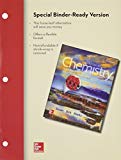
Concept explainers
(a)
Interpretation:
The determination of the molar mass of a gas if its density is
(a)
Explanation of Solution
The ideal gas equation is an equation that determines the relation between the pressure
The value of R in
The molar mass of a gas at STP can be determined by using the value of its density. The density
So, the molar mass of the gas can be determined by using molar volume of the gas, that is, assume
The conversion factor for temperature from Celsius to Kelvin is as follows.
For
The conversion of pressure from
For
Substitute the values in equation
The volume of the gas is, therefore,
The number of moles of the gas is equal to the ratio of the mass of the gas to the molar mass of that gas.
At STP, the number of moles of the gas is
(b)
Interpretation:
The determination of the molar mass of a gas if its density is
(b)
Explanation of Solution
Since the values of pressure and temperature are the same as those of the previous part, the volume of the gas is the same, that is,
The volume of the gas is, therefore,
The number of moles of the gas is equal to the ratio of the mass of the gas to the molar mass of that gas.
At STP, the number of moles of the gas is
(c)
Interpretation:
The determination of the molar mass of a gas if its density is
(c)
Explanation of Solution
Since the values of pressure and temperature are the same as those of the previous part, the volume of the gas is the same, that is,
The volume of the gas is, therefore,
The number of moles of the gas is equal to the ratio of the mass of the gas to the molar mass of that gas.
At STP, the number of moles of the gas is
(d)
Interpretation:
The determination of the molar mass of a gas if its density is
(d)
Explanation of Solution
Since the values of pressure and temperature are the same as those of the previous part, the volume of the gas is the same, that is,
The volume of the gas is, therefore,
The number of moles of the gas is equal to the ratio of the mass of the gas to the molar mass of that gas.
At STP, the number of moles of the gas is
(e)
Interpretation:
The determination of the molar mass of a gas if its density is
(e)
Explanation of Solution
Since the values of pressure and temperature are the same as those of the above part, the volume of the gas is the same, that is,
The volume of the gas is, therefore,
The number of moles of the gas is equal to the ratio of the mass of the gas to the molar mass of that gas.
At STP, the number of moles of the gas is
Want to see more full solutions like this?
Chapter 9 Solutions
Combo: Loose Leaf for Introduction to Chemistry with Connect Access Card Chemistry with LearnSmart 1 Semester Access Card
- Before small batteries were available, carbide lamps were used for bicycle lights. Acetylene gas. C2H2, and solid calcium hydroxide were formed by the reaction of calcium carbide, CaC2. with water. The ignition of the acetylene gas provided the light. Currently, the same lamps are used by some cavers, and calcium carbide is used to produce acetylene for carbide cannons. (a) Outline the steps necessary to answer the following question: What volume of C2H2 at 1.005 atm and 12.2 C is formed by the reaction of 15.48 g of CaC2 with water? (b) Answer the question.arrow_forwardAlthough we: generally think of combustion reactions as involving oxygen gas, other rapid oxidation reactions are also referred to as combustions. For example, if magnesium metal is placed into chlorine gas, a rapid oxidation takes place, and magnesium chloride is produced. msp;Mg(s)+Cl2(g)MgCl2(s) at Volume of chlorine gas, measured at STP, is required to react completely with 1.02gof magnesium?arrow_forwardA gas effuses through an opening one-fifth as fast as helium gas effuses through the same opening. (a) Is the gas heavier than helium? (b) What is the molar mass of the gas?arrow_forward
- Which of the following gas samples would have the largest volume, if all samples are at the same temperature and pressure? a 263g of Xe; b 51023 molecules of H2; c 4.00moles of CO2; d they would all have the same volume.arrow_forward5.18 When helium escapes from a balloon, the balloon’s volume decreases. Based on your intuition about stretching rubber, explain how this observation is consistent with the gas law.arrow_forward
 Chemistry for Today: General, Organic, and Bioche...ChemistryISBN:9781305960060Author:Spencer L. Seager, Michael R. Slabaugh, Maren S. HansenPublisher:Cengage Learning
Chemistry for Today: General, Organic, and Bioche...ChemistryISBN:9781305960060Author:Spencer L. Seager, Michael R. Slabaugh, Maren S. HansenPublisher:Cengage Learning Chemistry: Principles and ReactionsChemistryISBN:9781305079373Author:William L. Masterton, Cecile N. HurleyPublisher:Cengage LearningChemistry: Matter and ChangeChemistryISBN:9780078746376Author:Dinah Zike, Laurel Dingrando, Nicholas Hainen, Cheryl WistromPublisher:Glencoe/McGraw-Hill School Pub Co
Chemistry: Principles and ReactionsChemistryISBN:9781305079373Author:William L. Masterton, Cecile N. HurleyPublisher:Cengage LearningChemistry: Matter and ChangeChemistryISBN:9780078746376Author:Dinah Zike, Laurel Dingrando, Nicholas Hainen, Cheryl WistromPublisher:Glencoe/McGraw-Hill School Pub Co Introductory Chemistry: An Active Learning Approa...ChemistryISBN:9781305079250Author:Mark S. Cracolice, Ed PetersPublisher:Cengage Learning
Introductory Chemistry: An Active Learning Approa...ChemistryISBN:9781305079250Author:Mark S. Cracolice, Ed PetersPublisher:Cengage Learning Principles of Modern ChemistryChemistryISBN:9781305079113Author:David W. Oxtoby, H. Pat Gillis, Laurie J. ButlerPublisher:Cengage Learning
Principles of Modern ChemistryChemistryISBN:9781305079113Author:David W. Oxtoby, H. Pat Gillis, Laurie J. ButlerPublisher:Cengage Learning General Chemistry - Standalone book (MindTap Cour...ChemistryISBN:9781305580343Author:Steven D. Gammon, Ebbing, Darrell Ebbing, Steven D., Darrell; Gammon, Darrell Ebbing; Steven D. Gammon, Darrell D.; Gammon, Ebbing; Steven D. Gammon; DarrellPublisher:Cengage Learning
General Chemistry - Standalone book (MindTap Cour...ChemistryISBN:9781305580343Author:Steven D. Gammon, Ebbing, Darrell Ebbing, Steven D., Darrell; Gammon, Darrell Ebbing; Steven D. Gammon, Darrell D.; Gammon, Ebbing; Steven D. Gammon; DarrellPublisher:Cengage Learning





